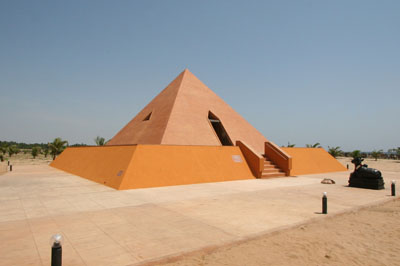
USA, Pagosa Springs - Buddhist retreat (Photo Jim Hallock)
|

Cinvaram - The first press for compressed earth blocks
|

Burkina Faso, Ouagadougou - Pan African Institute (Photo Th. Joffroy)
|

Zaire, Kinshasa - School sponsored by UNIDO
|

Ivory coast - Restaurant
|

Ivory coast, Afotobo - Cost effective house built in 10 days by trainees
|

Mali, Bamako - National Research Centre (Photo J.L. Pivin)
|

Mali, Bamako - French Cultural Centre (Photo J.L. Pivin)
|

Marocco, Marrakech - Apartments (Photo H. Guillaud)
|

Egypt, Fayoum - House (Architect & photo Adel Fahmy)
|

Egypt, Gizah - House (Architect & photo Adel Fahmy)
|

Turkey, Istanbul - Minimum Emergency House
|

France, Mayotte - Social housing (Photo Th. Joffroy)
|

France, Mayotte - Prefecture (Photo Th. Joffroy)
|

France, Mayotte - Airport (Architect Pascal Rollet)
|

France, Mayotte - Office of tourism (Architect Pascal Rollet)
|

Madagascar, Antananarivo - House (Photo Th. Joffroy)
|

Somalia, Genale - School sponsored by UNESCO
|

France, Grenoble - House built in 30 hours
|

Salvador - Earthquake resistant house
|

India, New Delhi - Ex Headquarters of Development Alternatives
|

India, Bangalore - Eco resort Hessarghatta (Arch Chitra Vishwanath)
|

India, Gujarat Khavda - 23 m2 house built in 62 h. by an 18 man team
|

India, Gujarat - Earthquake resistant house
|

Auram press 3000, multi mould manual press with 17 moulds
|

India, Tamil Nadu, Auroville - Visitors Centre
|

India, Tamil Nadu, Auroville - Solar community kitchen
|

India, Tamil Nadu - Sri Karneshwara Nataraja temple
|

Saudi Arabia, Janadriyah - Exhibition Centre
|

Saudi Arabia, Riyadh - Al Medy Mosque built in 7 weeks
|

Colombia, Near Bogota - Apartments (Arch. Mauricio Sanchez)
|

Colombia, Near Bogota - Architect Mauricio Sanchez
|

Colombia, Near Bogota - Convention centre (Arch. Dario Angulo)
|

Colombia, Near Bogota - Apartments (Arch. Dario Angulo)
|

Bangladesh, Dacca - Training Institute (Architect Kirtee Shah)
|

Bangladesh, Dacca - Training Institute (Architect Kirtee Shah)
|

Gambia, Sandele - Resort
|

Gambia, Sandele - Resort
|

Mexico - House by Ital Mexicana
|

Mexico, Loreto Bay - Houses by Tierra y Cal
|

Nigeria, Kaduna mosque
|

Iran, Bam - Earthquake resistant house
|













































